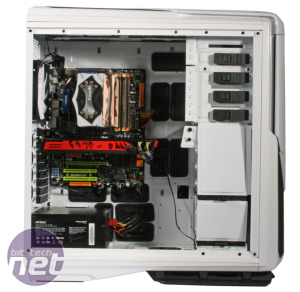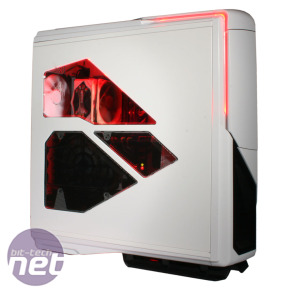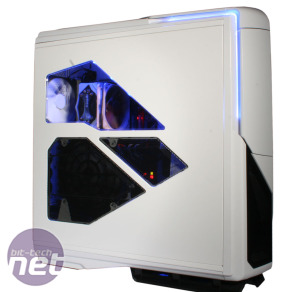
Performance Analysis
With the Phantom 820's four fans set to their lowest speed, the temperatures were not very impressive, although noise levels were low, especially given the amount of meshing around the case. The CPU delta T of 52˚C left it mid-league, warmer than other large cases like the Xigmatek Elysium, but the GPU delta T, also 52˚C, put it right near the bottom of the table, even behind the BitFenix Shinobi XL, which lacks a side intake fan.When we ramped the system fans up to their maximum speed, we were pleased to note that while the fans certainly became more noticeable in their noise output, the overall effect was far from deafening and still on the quiet side. At this setting, the case shed 4˚C from the CPU delta T, taking it to a much more respectable 48˚C, equalling that of the Cooler Master HAF X. The rear and roof exhaust fans clearly do an admirable job of exhausting hot air from the CPU area – NZXT's own Switch 810 had a similar set up and achieved the same result.
GPU temperatures remained disappointing at high speed, however, levelling out at a delta T of 49˚C, the same as the heavily insulated Fractal Design Define R4. We were expecting better results from the 200mm side intake, but after checking and repeating the test the results remained the same. Cool air was obviously having a tough time reaching the GPU, as the side fan did sit quite low compared to our graphics card and span fairly slowly, even at high speed. Also, the front intake sits some distance from the GPU, is likewise a slow spinner and has its airflow path blocked by the non-removable drive cage.
Conclusion
It's rare for a case to stand out these days, as the case market is littered with average performers, but the Phantom 820 stood out in many ways. The case has almost every feature you could ask of it, and more importantly they're implemented in sensible ways rather than just thrown in to bulk out the features list. The water-cooling support is phenomenal, and the fan and LED controls leave little room for improvement. The SD card reader, numerous dust filters and small army of USB ports ensure that almost every need is covered with the Phantom 820.The design of the case, too, left us wanting little. It's a pleasure to work with, well built, and excellent in terms of cable management. The shoddy drive mounting devices are really the case's only real design flaw. CPU cooling is really quite good, but the GPU cooling does let the case down a bit. We only wish a fan had been included in the internal positional fan mount, as this gave NZXT's own Switch 810 (which lacks a side fan) an advantage over the Phantom 820 for cooling graphics hardware.
£200 is a lot to ask for a case, but the Phantom 820 goes a long way to justifying its price tag, and we've no hesitation in recommending it. It won't be for everyone at this price, but for those with high end hardware and the cash to splash, it's a great choice. Water-coolers will be well served in almost every respect, and even those sticking to air cooling will net themselves a fantastic case assuming they don't mind adding in a 120mm or 140mm fan to that internal mount.

-
Cooling19 / 30
-
Features19 / 20
-
Design29 / 30
-
Value16 / 20


MSI MPG Velox 100R Chassis Review
October 14 2021 | 15:04












Want to comment? Please log in.